This past Friday’s Ligue 1 fixture saw two European qualification hopefuls go head to head, as Monaco hosted Montpellier. Monaco went into Friday’s game trailing Montpellier by two points. However, thanks to a 52nd minute headed Islam Slimani goal, via a successful corner kick, Monaco earned an important 1-0 win which takes them up to fifth place in Ligue 1, now one point ahead of Montpellier, who sit in sixth place.
Friday’s game saw Monaco earn their third straight Ligue 1 victory. Robert Moreno’s men now sit just three points behind third-placed Rennes. With 13 games left to be played in the 2019/20 Ligue 1 season, the battle for the third UEFA Champions League place, as well as the automatic Europa League group stage qualification awarded to Ligue 1’s fourth-placed side, is as competitive as ever.
This tactical analysis piece will examine the key elements of both Monaco and Montpellier’s tactics from Friday’s contest. We will provide a tactical analysis of the key differences in both Monaco and Montpellier’s offensive and defensive shapes from this game, as well as the differences in both sides’ respective tactical methods in attack and defence from this fixture.
Lineups and formations
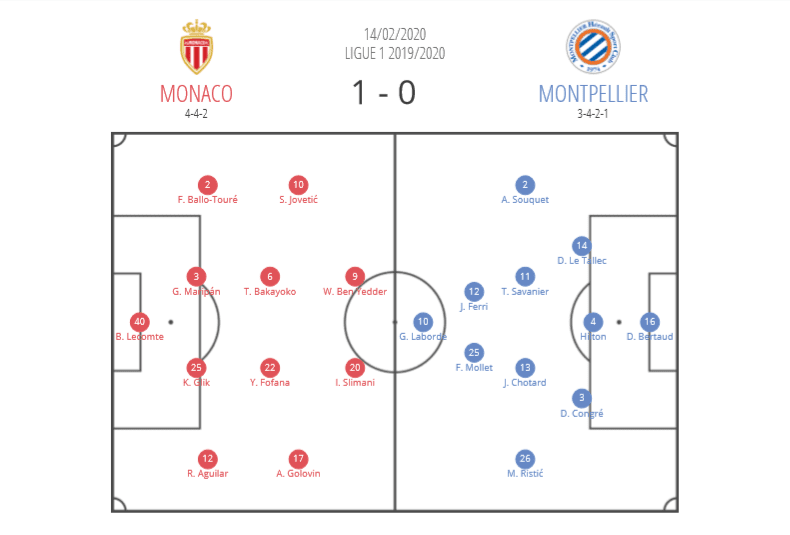
Robert Moreno lined up his men in a 4-3-1-2 shape in-possession for Friday’s fixture. Monaco’s front three of Slimani, Wissam Ben Yedder, and Stevan Jovetić would interchange their exact position within the front three quite a bit, however, the shape of one forward playing slightly deeper in the ‘10’ role behind the other two, who played more advanced roles, remained consistent throughout this game.
Youssouf Fofana occupied the holding midfield position for this game. As a result, the 21-year-old rarely ventured forward. Instead, he provided defensive cover and operated as a deeper source of creativity as Monaco attacked. Fofana’s role in the midfield allowed his midfield partners Aleksandr Golovin and Tiémoué Bakayoko to venture further forward.
Monaco switched to a 4-4-2 in the defensive phase. Jovetić would generally be the forward who dropped into the midfield four in defence. Jovetić occupied the left-wing position out-of-possession, while Golovin shifted out to the right-wing. This left Bakayoko and Fofana in the centre. Monaco’s 4-4-2 defensive shape allowed them to cover the wide areas of the pitch to a greater extent than their 4-3-1-2 offensive shape would allow.
Michel Der Zakarian lined the visiting side up in a 3-4-2-1 shape for Friday’s game. In the offensive phase, Montpellier’s wing-backs, Arnaud Souquet and Mihailo Ristić would generally push up to provide Montpellier’s offensive width. This resulted in their shape turning into something of a 3-2-4-1 in the attack.
However, in the defensive phase, left wing-back Souquet and right wing-back Ristić would drop deep into the defensive line. As a result, Montpellier generally defended in a 5-2-2-1, or 5-4-1 shape throughout this game. As the game wore on, in need of a goal, Montpellier switched to a 4-4-2, however, their change in shape wasn’t enough to help them find an equalising goal.
Monaco’s more aggressive press
Monaco pressed Montpellier from the front quite aggressively throughout this game. Monaco’s average PPDA for Friday’s fixture was just 8.2. This means that on average, over the course of this game, Monaco allowed Montpellier to play 8.2 passes before committing a defensive action.
In comparison, Montpellier’s PPDA was 15 for Friday’s game, almost twice as high as Monaco’s. Furthermore, Monaco made 34 of their 86 recoveries in the opposition half, while Montpellier made just 17 of their 83 recoveries in the opposition half. All of this backs up that the home side pressed more aggressively in Friday’s game.
Montpellier generally defended quite passively during Monaco’s build-up for the majority of this game. This allowed Monaco’s defenders more time on the ball, as Montpellier opted to defend deeper.
However, the home side defended from the front for the majority of Friday’s game, pressing Montpellier’s defence quite aggressively. This made it difficult for Montpellier to build out from the back. Monaco’s aggressive defensive tactics were successful in forcing turnovers in dangerous areas of the pitch.
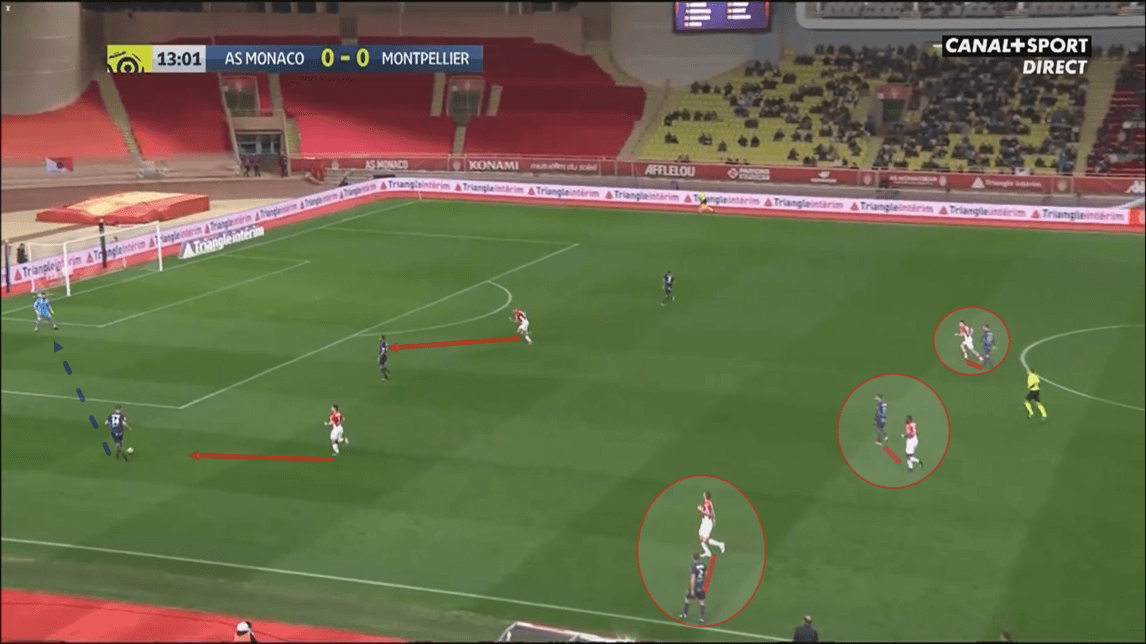
The image above shows us an example of Monaco’s high press in action. Here, we can see Ben Yedder pressing the centre-back in possession, forcing him to play the ball back to the goalkeeper, Dimitry Bertaud. We can also see Ben Yedder’s strike partner Slimani pressing Montpellier’s backline here.
As the play goes on, Slimani continues running to press Bertaud as he receives possession. As he receives the ball on his right foot and under pressure, Bertaud subsequently plays the ball back out to the right centre-back who we can see in possession originally in the image above. Ben Yedder continues his press on the centre-back, forcing him back to the byline and eventually winning the ball.
This passage of play shows us just one example of the effectiveness of Monaco’s high press in Friday’s game. As previously mentioned, Les Monégasques successfully forced turnovers in the opposition half 34 times throughout Friday’s game.
This image also shows us that Monaco’s midfield also pressed quite high during Montpellier’s build-up. Monaco’s midfield line didn’t press as aggressively as their front two, however, they marked some of Montpellier’s slightly more advanced passing options, positioned near to them.
Here, we can see Jovetić at left-midfield marking right wing-back Souquet, Bakayoko marking right central midfielder Téji Savanier, and Golovin marking left central midfielder
Joris Chautard. This was effective at preventing Montpellier from simply playing the ball past Monaco’s forwards in the build-up, as their defenders’ nearest viable passing options were being marked tightly.
Montpellier’s wide-forwards support the midfield in the build-up
Monaco’s press was undoubtedly effective at hindering Montpellier’s attempts at building out from the back at times in this game. However, Montpellier did enjoy some successful passages of build-up play. Their wide forwards, Florent Mollet and Jordan Ferri, dropped to occupy deeper positions at times to help their side progress the ball effectively.
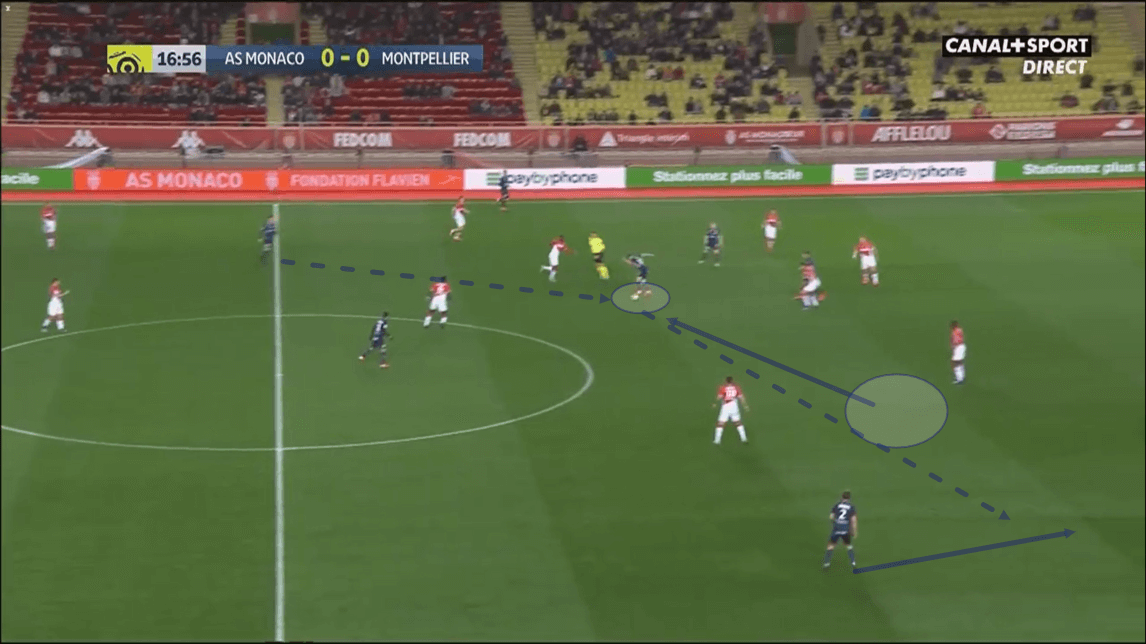
The image above shows us an example of how Montpellier’s wide forwards assisted their side during the build-up play. On this occasion, we can see Ferri dropping from his more advanced position on the right side of Montpellier’s attack to a deeper position where he can offer an attractive short-passing option to his deeper midfield teammate Chotard.
Ferri’s movement helps his side to break Monaco’s press, as he receives possession in between Monaco’s two lines of four. As Ferri receives the ball, we can see Fofana begin to close him down aggressively. However, Ferri receives the ball well and manages to turn and quickly play right wing-back Souquet through on the overlap.
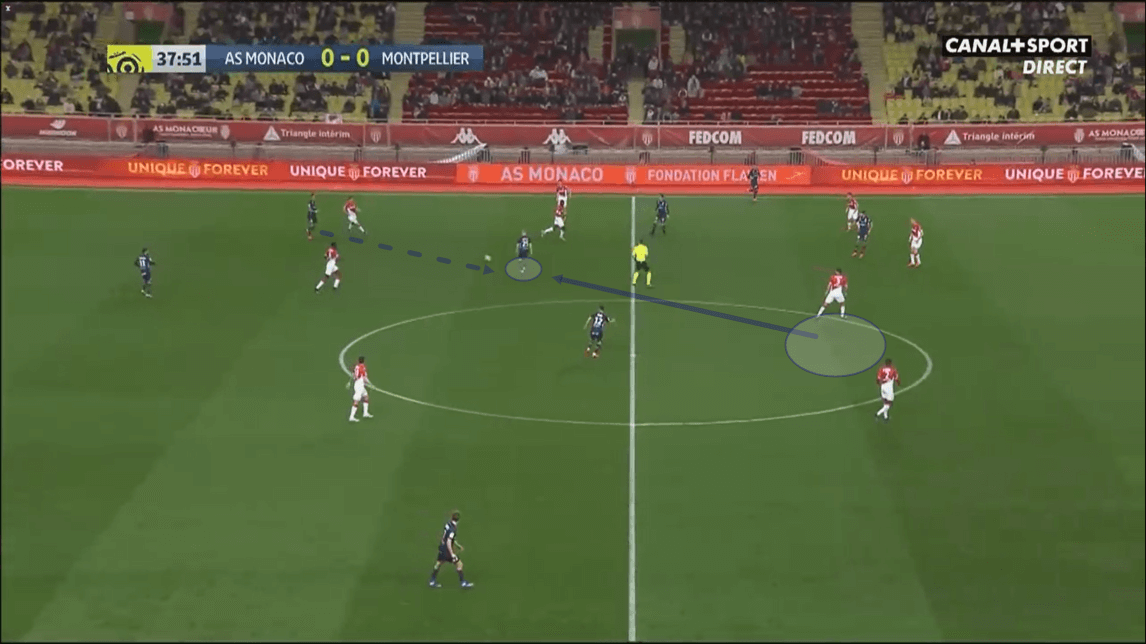
This second image provides us with another example of one of Montpellier’s wide forwards dropping deep to help in the build-up. On this occasion, we can see Mollet providing support to his midfielders by dropping deep.
Similarly to Ferri in the previous example, Mollet had been occupying the position on the right side of Montpellier’s attack just prior to this image being taken. As his side attempt to play past Monaco’s press, the attacker withdraws from his advanced position, to offer increased support to his midfield.
Mollet’s movement allows him to become an easy short-passing option for left centre-back Daniel Congré. Congré subsequently picks out the attacker in the midfield. This, once again, helps Montpellier to play past Monaco’s aggressive press.
As these examples show, it is clear that despite Monaco utilising their high press quite effectively, Montpellier did manage to build past it at times. Montpellier’s wide forwards played a crucial role in helping their team to break Monaco’s press on these occasions.
Montpellier’s width
The visitor’s shape allowed their wing-backs to push forward and play an important role in their attack. The visiting side attempted to exploit the width provided by their wing-backs throughout the entirety of Friday’s game. Exploiting the width, via the wing-backs was Montpellier’s primary offensive tactic in Friday’s game.
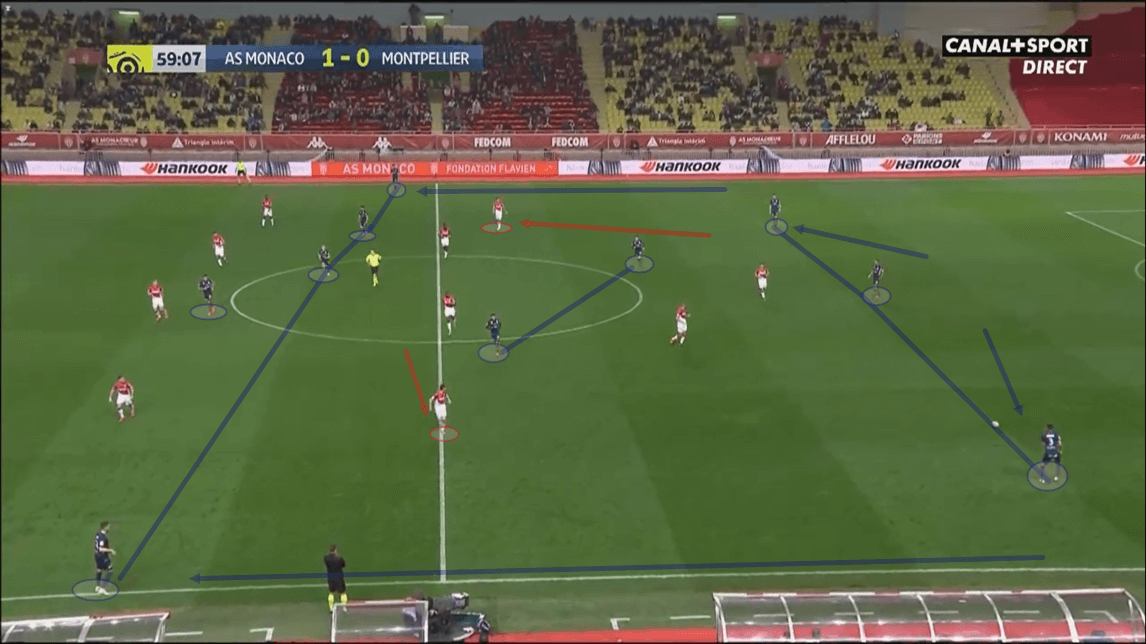
Firstly, this image above shows us how Montpellier’s shape looked in-possession. As we can see, during the build-up, Montpellier’s two wide centre-backs would shift out into wider positions. As the wide centre-backs shifted wider, the two wing-backs pushed further up the pitch, on each wing. As this image shows, this effectively created a 3-2-4-1 shape in-possession.
This image also shows us how Montpellier’s two central midfielders staggered their positions during the build-up at times. This staggering was effective at helping the two central midfielders to become more difficult to defend for Monaco’s 4-4-2. The staggering of the two central midfielders helped them to become more viable passing options for the centre-backs who had struggled to find them at times under pressure.
As we can see here, Montpellier’s two wing-backs exploit the full width of the pitch. Both wing-backs position themselves to touch both of their respective touchlines. This positioning allowed them to occupy space outside of Monaco’s more narrow defensive shape.
As the ball is played over to Montpellier’s left centre-back in this image, we can see Monaco’s shape moving over to that wing. This movement out-of-possession helped Monaco to provide additional cover for Montpellier’s offensive wing-backs. However, the wing-backs’ positioning combined with the positioning of Montpellier’s two central midfielders and two wide forwards, positioned inside each of the two wing-backs, made it difficult to prevent Montpellier from building out to the wings at times.
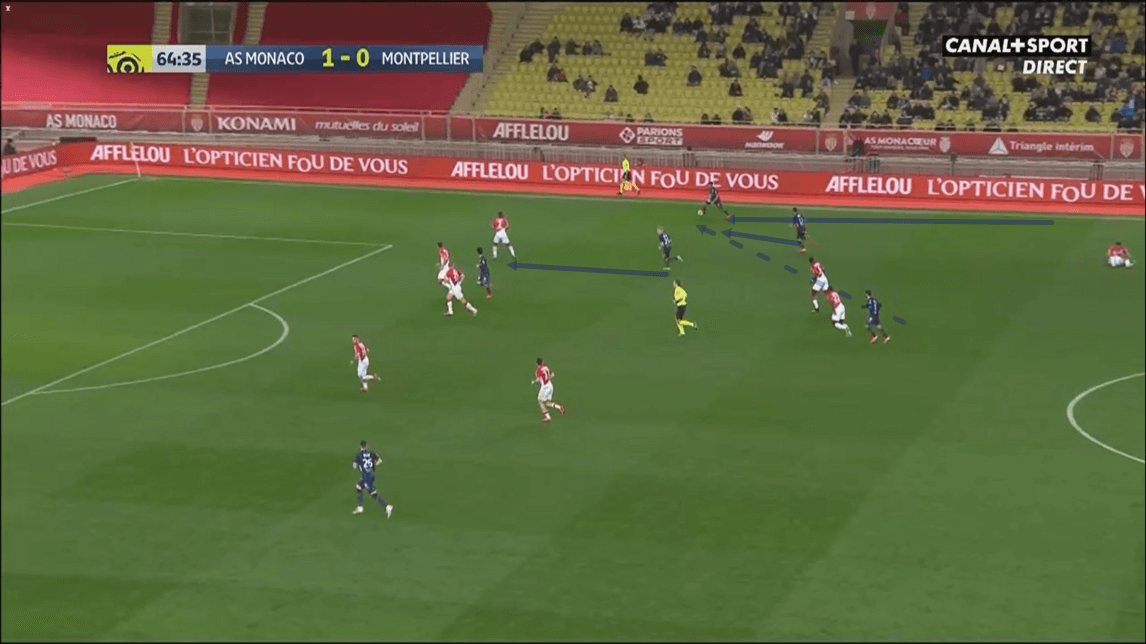
This next image shows us an example of Montpellier exploiting the width in this game. As we can see in this image, right wing-back Souquet had received possession on the overlap high on the right-wing just prior to this image. Savanier picked his run out as he received possession in central midfield.
As Souquet receives possession, he is supported by the runs of the two wide forwards, Ferri and Mollet, both of whom can be seen positioned close to Souquet on the right-wing in this image. This shows us an example of Montpellier successfully creating an overload on the right-wing. Montpellier were dangerous when they got into this position in Friday’s game.
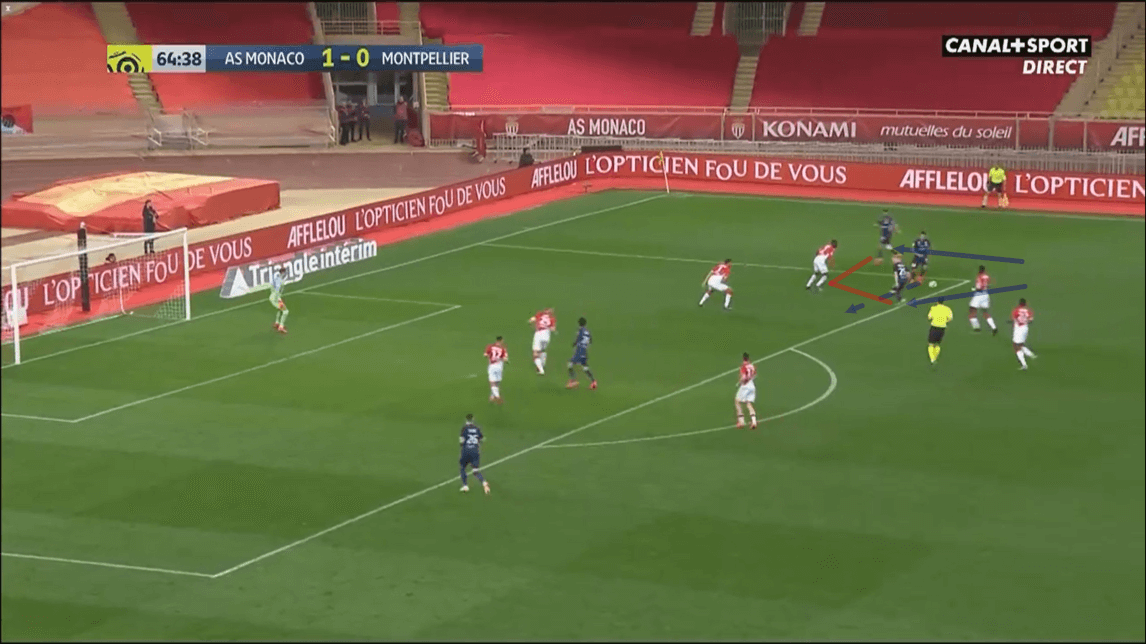
As this passage of play continues, Ferri makes an overlapping run on the outside of Souquet as he carries the ball infield. Meanwhile, Mollet continues his run providing Souquet with a passing option on the inside. This essentially creates a 3v1 situation on the right-wing in favour of Montpellier. We can see this in action in the image above.
Monaco left-back Fodé Ballo-Touré has to be mindful of both the overlapping run of Ferri as well as Mollet’s run into the right half-space, as Souquet also continues his run with both wide forwards as a passing option.
As the play moves on, Souquet plays the ball through to the more central option of Mollet. Mollet quickly beats Ballo-Touré and forced centre-back Kamil Glik to make a crucial tackle. This passage of play shows us an example of how Montpellier threatened Monaco down the wings throughout this game.
On occasions when the visitors managed to advance play down the wings, they successfully threatened the hosts. However, they were ultimately unable to break down Monaco’s defence enough to score a goal.
The role of Monaco’s three central attackers in the build-up
Similarly to Montpellier’s forwards, Monaco’s three central attackers also played an important role in the build-up for their side here. Monaco tried to play the ball into one of their three forwards relatively quickly throughout Friday’s game. They were able to do so due to the movement of their three forwards. Though one of their forwards would usually occupy the ‘10’ position, one of their other two strikers would also drop deep at times to provide an option during the build-up.
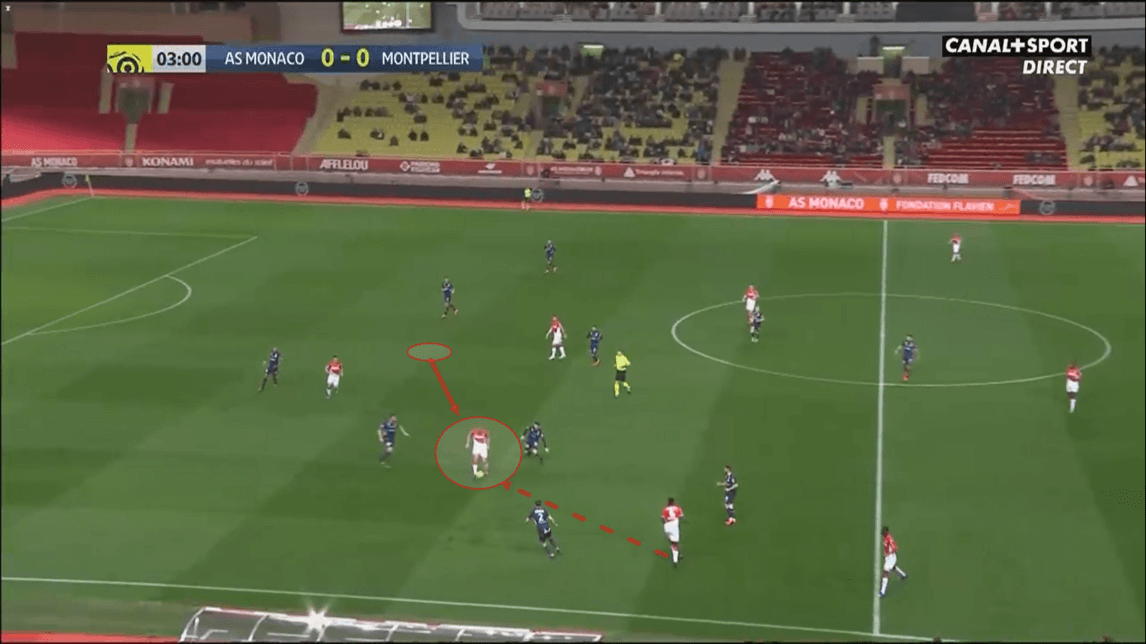
The image above provides us with an example of Slimani dropping deep from his advanced position into the left half-space. Bakayoko had been in possession of the ball on the left-wing just prior to this image. Slimani subsequently made a supporting run towards the left central midfielder. Bakayoko then played the ball into the feet of the Algerian forward, which we can see in the image above.
On this particular occasion, as Slimani receives possession he is hounded by the three Montpellier players surrounding him, which we can see here. Slimani is also unable to control the ball quickly enough on this occasion which leads to Montpellier winning the ball back rapidly.
However, this passage of play provides us with a clear example of the way in which Monaco’s forwards were used in the build-up for the majority of this game. When Monaco had progressed the ball into the midfield, the forwards would often drop into positions like the one Slimani is seen occupying in this image, to receive the ball to feet.
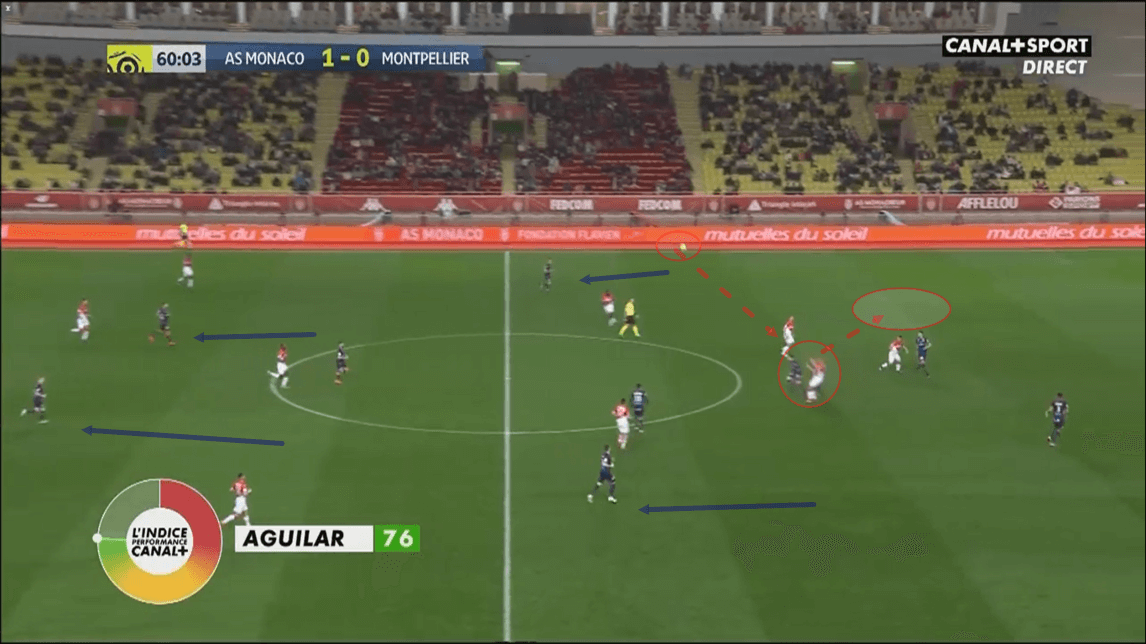
This next image provides us with an example of how the aerial ability of Monaco’s forwards was also utilised in the build-up throughout this game. On this occasion, once again, Slimani can be seen dropping slightly deeper than Ben Yedder. Slimani drops into this position to the right of Ben Yedder as goalkeeper Benjamin Lecomte takes a long goal kick.
Monaco frequently used long-balls directed towards, usually Slimani, throughout Friday’s contest. Slimani contested a total of nine aerial duels in this game. That is a higher number of aerial duels than any other player contested for either side throughout this fixture. The Monaco forward also won five of the nine aerial duels that he contested, proving his effectiveness in that role.
Monaco’s centre-backs often opted for the long-ball in the first half. However, as the game wore on, and after Monaco had taken the lead, Montpellier began to deploy a more aggressive press from the front. In doing so, they became less compact in deeper areas.
This allowed Slimani to get into positions like the one in the image above to exploit the space between the lines. As Slimani dropped slightly deeper to contest aerial duels, he could flick the ball onto Ben Yedder to run in behind Montpellier’s higher defensive line. We can see an example of this in the image above.
Whether Monaco were playing it short from the midfield or long from deeper positions, the three forwards played an integral role in their side’s build-up play in this game.
Monaco’s effective positional manipulation of Montpellier’s wing-backs
One of Monaco’s most effective offensive tactics in last Friday’s game was there effective positional manipulation of Montpellier’s wing-backs. Monaco’s full-backs, midfielders and forwards all had important roles to play in implementing this tactic effectively in Friday’s game.
Montpellier defended quite narrow for the most part in Friday’s game. Their wide forwards generally remained relatively narrow out-of-possession. Monaco frequently exploited Montpellier’s lack of defensive width by utilising quick switches of play in the build-up.
As Montpellier’s wide forwards didn’t offer a lot of defensive covers out wide, Montpellier’s wing-backs were pulled out of the defence and forced to defend quite high up the pitch when Monaco’s full-backs received possession on the wings.
Due to Monaco’s central three attackers, Montpellier’s three centre-backs were also pinned into the centre and prevented from shifting out wide to offer much cover for the wing-backs. As a result, a large gap was created in these situations, between the wing-back and the centre-backs.
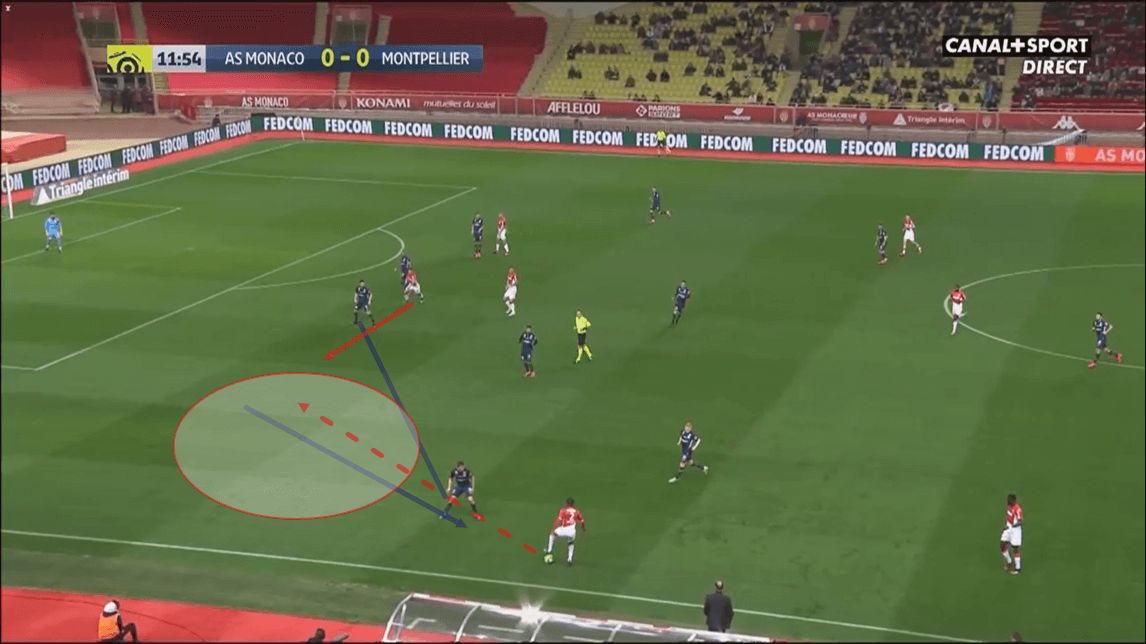
The image above provides us with one example of Monaco creating, and subsequently exploiting, this gap. On this occasion, we can see Ballo-Touré in possession on the left-wing. As he receives possession, Souquet is forced out of Montpellier’s back five, to close him down.
However, as we can see, Montpellier’s three centre-backs remain central, as Monaco’s three central attackers are all threatening central areas. This creates a large gap between Souquet and right centre-back, Damien Le Tallec. Furthermore, this also creates a large amount of space on the left-wing, behind Souquet.
As play moves on here, Ben Yedder quickly runs from his central position out into the space created on the left-wing. This makes Ben Yedder a progressive passing option for Ballo-Touré, who goes on to play the ball through to Ben Yedder. The forward subsequently advances into space on the left-wing, with possession.
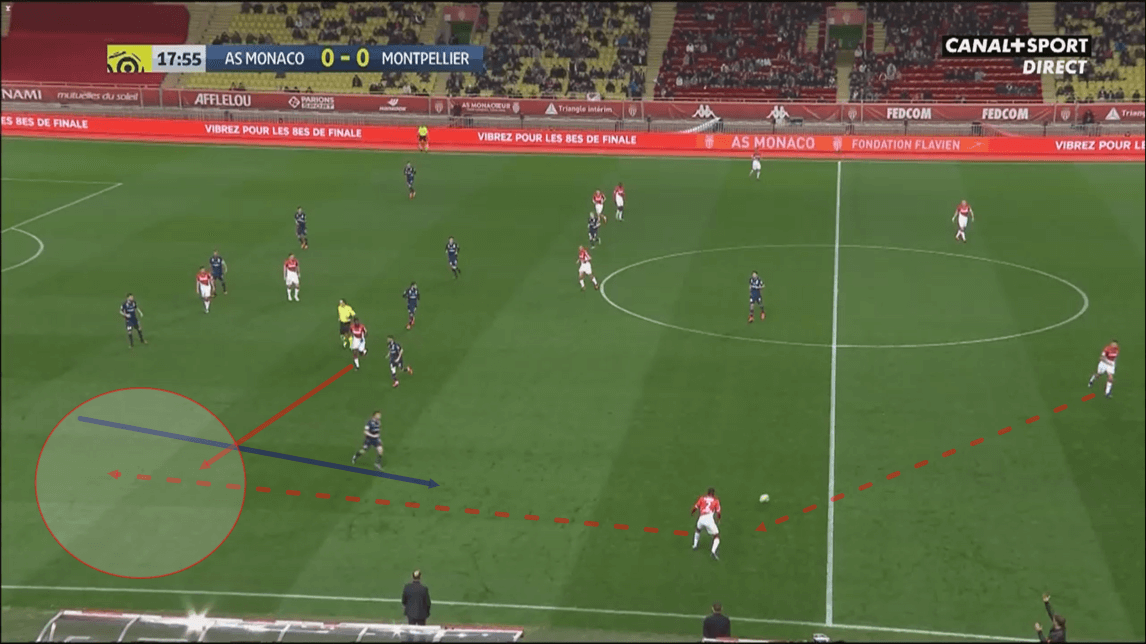
This next image shows us another example of Monaco manipulating the defensive movement of Souquet at right wing-back. Here, we can see Ballo-Touré receiving the ball in a deeper position than in the previous image. However, Souquet, once again, is the player tasked with pressing the left-back.
As Soquet presses Ballo-Touré, this creates a large amount of space behind the Montpellier man once again. As he is deeper on this occasion, Ballo-Touré can pick out a run from left central midfielder Bakayoko here. Bakayoko probes into the space that has been freed up on the left-wing. The midfielder makes a threatening run, beating his marker, however, the ball from Ballo-Touré ultimately goes out of play.
Though this attack ultimately fizzled out, it provides us with yet another example of Monaco’s effective manipulation of Montpellier’s wing-back positioning.
Conclusion
To conclude this tactical analysis piece, it’s clear that both of these sides deployed some effective tactics in their attempts to break down the other team in this game. Monaco’s use of their front three, in addition to their exploitation of Montpellier’s defensive movement, was effective at creating goalscoring chances for them here.
Furthermore, Monaco’s high press was effective both at hindering Montpellier’s attempts at building out from the back, as well as also creating more goalscoring opportunities as they forced transitions in dangerous areas of the pitch.
Meanwhile, despite struggling to beat Monaco’s press for lengthy periods of this game, Montpellier displayed some effective tactics in the build-up, as they utilised the movement of their wide forwards to support the midfield and break Monaco’s press at times in Friday’s contest.
Montpellier’s exploitation of the wide areas was also effective in this game. However, despite utilising some effective tactics, they were unable to create enough chances to score past a solid Monaco defence.





Comments